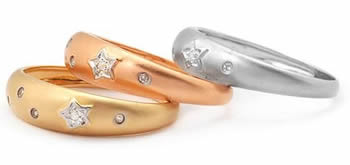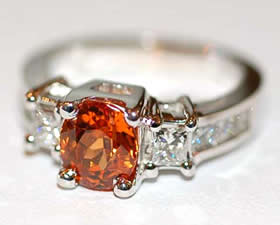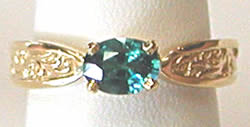|
Reviewed By Andreas Zabczyk
Uniqueness of Gold
Colors of Gold
As the price of gold has risen to nearly $1,000 a troy ounce, it made us wonder about the fascination with gold. What is it about this yellow metal that has captivated so many cultures for so long? What is the allure of gold? Gold is a rare and valuable metal, but it is hardly the rarest or most valuable. Platinum, the current favorite in high-end jewelry, sells for a price almost double that of gold. Some rarer metals are even more expensive. Rhodium, a member of the platinum group, has been selling at prices near $9,000 an ounce in 2008. The look of gold - shiny, yellow and dense - is undoubtedly one of the reasons for its appeal. However, there have been many periods throughout modern times when white gold was the fashion rather than yellow gold. White gold was first introduced in the 1920s by creating alloys with nickel, platinum, palladium, silver or zinc. 
Spessartite Garnet in an 18k White-Gold Ring
Chemically, gold has many interesting and unusual properties. It is the most malleable and ductile of all metals, meaning it can be stretched and deformed without fracturing. In fact a single gram of gold can be beaten into a thin sheet as large as one square meter. The softness and malleability of gold suggest it was likely the first metal worked by prehistoric man. Gold is one of the so-called noble metals, which are resistant to corrosion and oxidation, unlike most base metals. The noble metals include gold, silver, platinum, mercury and copper. Gold is insoluble in nitric acid, so nitric acid has long been used to identify genuine gold. The phrase "acid test" thus entered the English language to refer to any test for genuine value. Gold's stability make it especially appropriate for jewelry. Heat, moisture, oxygen and most corrosive agents have very little chemical effect on gold. However, pure gold is too soft for most jewelry. Fortunately, gold easily forms alloys with many other metals, and these can be used to increase its hardness as well as change its color. Pure gold is called 24 karat (abbreviated to 24k) gold, while 22k is 91.6% gold. Lower karatages are popular, including 18k (75% gold) and 14k (58.5% gold). Despite its softness, 24k jewelry is very popular in Asia. 
Gold alloys can be created in a variety of colors, including rose gold, yellow gold, bronze gold and white gold. It is even possible to make unusual colors such as blue gold by alloying it with iron; and purple gold by alloying gold with aluminum. The malleability of gold and its range of colors continues to make it the most popular choice for gemstone jewelry. There is a color of gold that suits any skin tone or gemstone hue, whether your preference is for sapphire, ruby, tourmaline, garnet or zircon. |
| STAY IN TOUCH | NEWSLETTER |
| *You're signing up to receive GemSelect promotional email. |
Copyright © 2005-2024 GemSelect.com all rights reserved.
Reproduction (text or graphics) without the express written consent of GemSelect.com (SETT Company Ltd.) is strictly prohibited.
614